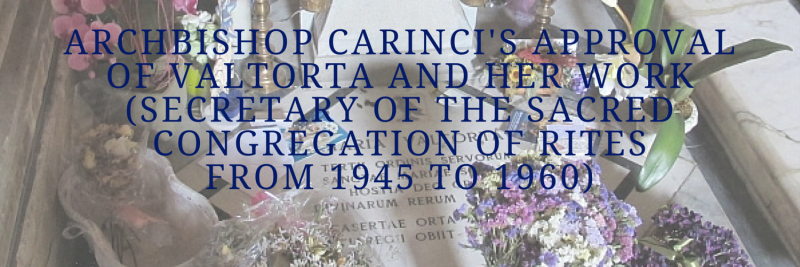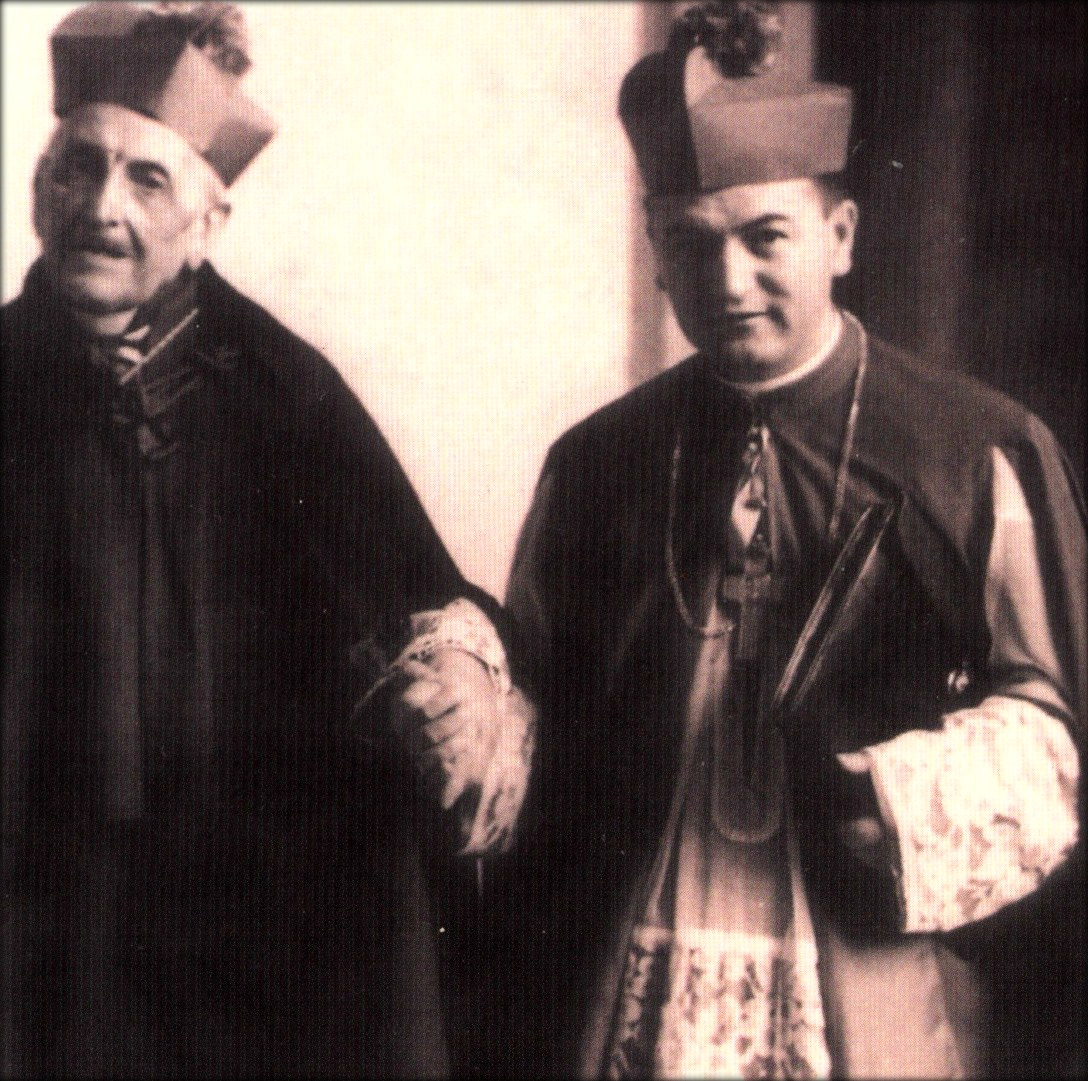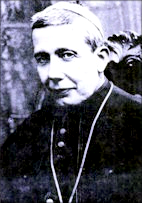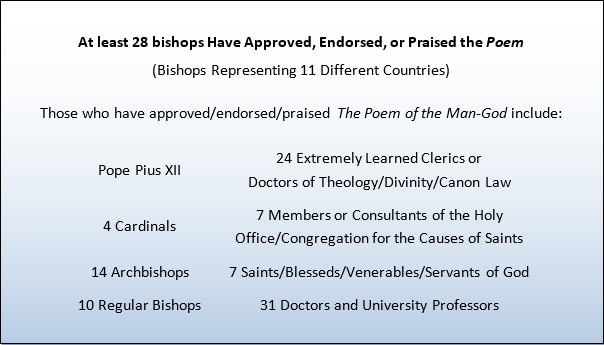
(Secretary of the Sacred Congregation of Rites from 1930 to 1960)

Archbishop Alfonso Carinci on His 101st Birthday and Bishop Alcides Mendoza, Aged 34.
 Archbishop Alfonso Carinci (1862-1963) was the Secretary of the Sacred Congregation of Rites from 1930 to 1960 (which was later renamed the Congregation for the Causes of Saints in 1969). Archbishop Carinci was in charge of investigating causes for pre-Vatican II beatification and canonization. He was conversant in recognizing true and false sanctity and was of distinguished repute. He was master of ceremonies for Pope Leo XIII and a confidant of Pope St. Pius X. He was also rector of the Almo Collegio Capranica from 1911 to 1930, where Cardinal Eugenio Pacelli (the future Pope Pius XII) was formed. Many prelates considered him to have passed away in the odor of sanctity.
Archbishop Alfonso Carinci (1862-1963) was the Secretary of the Sacred Congregation of Rites from 1930 to 1960 (which was later renamed the Congregation for the Causes of Saints in 1969). Archbishop Carinci was in charge of investigating causes for pre-Vatican II beatification and canonization. He was conversant in recognizing true and false sanctity and was of distinguished repute. He was master of ceremonies for Pope Leo XIII and a confidant of Pope St. Pius X. He was also rector of the Almo Collegio Capranica from 1911 to 1930, where Cardinal Eugenio Pacelli (the future Pope Pius XII) was formed. Many prelates considered him to have passed away in the odor of sanctity.
He praised Maria Valtorta and The Poem of the Man-God (now entitled The Gospel as Revealed to Me), writing in 1952:1
“There is nothing therein which is contrary to the Gospel. Rather, this work, a good complement to the Gospel, contributes towards a better understanding of its meaning... Our Lord's discourses do not contain anything which in any way might be contrary to His Spirit.”
Archbishop Carinci also stated:2“...it seems impossible to me that a woman of a very ordinary theological culture, and unprovided with any book useful to that end, had been able on her own to write with such exactness pages so sublime.”
He visited Maria Valtorta three times, said Mass for her, read her writings in depth, wrote many letters back and forth with her, and analyzed her case. He was so convinced that her writings were inspired by God, that eyewitnesses report he would say to Maria Valtorta: “He is the Master. He is the Author,” and in his letters to Maria Valtorta, he wrote “Author” with a capital “A”.3 Archbishop Carinci was one of two prominent authorities who advised Fr. Corrado Berti to deliver typewritten copies of The Poem of the Man-God to Pope Pius XII, which led to his command to publish it in 1948.4 In January 1952, Archbishop Carinci also wrote a thorough certification and positive review of Valtorta’s work (four pages long when typed), which has been published.5 That same year, he also wrote a letter on behalf of himself and eight other prominent authorities (among them, two Consultants to the Holy Office, three professors at pontifical universities in Rome, a Consultant to the Sacred Congregation of Rites, and the Prefect of the Vatican Secret Archive) to be delivered to Pope Pius XII in an audience, although the audience wasn’t able to be arranged.6 Archbishop Carinci is also one of the authorities whose favorable certifications about Maria Valtorta was given to the Holy Office in 1961 by Fr. Corrado Berti, which led the Holy Office to grant their approval of the publication of the second edition of her work.7The book Lettere a Mons. Carinci (Letters to Archbishop Carinci) is a collection of letters that Maria Valtorta and Archbishop Alfonso Carinci exchanged between January 9, 1949 and December 23, 1955. The book contains 39 letters in full written by Maria Valtorta to Archbishop Carinci and 21 letters in full written by Archbishop Carinci to Maria Valtorta, including photoscans of some of the original handwritten letters. In the book Pro e contro Maria Valtorta, on page 92 is a photocopy of the original signed handwritten letter of Archbishop Carinci, written on behalf of himself and eight other prominent authorities, to be delivered to Pope Pius XII in an audience and which is dated January 29, 1952. It also has a very positive certification and review of her work (four pages long when typed) written by Archbishop Carinci on January 17, 1952.
In this letter, Archbishop Carinci wrote:8
“Judging from the good one experiences in reading it [i.e., The Poem], I am of the humble opinion that this Work, once published, could bring so many souls to the Lord: sinners to conversion and the good to a more fervent and diligent life. […] While the immoral press invades the world and exhibitions corrupt youth, one comes spontaneously to thank the Lord for having given us, by means of this suffering woman, nailed to a bed, a Work of such literary beauty, so doctrinally and spiritually lofty, accessible and profound, drawing one to read it and capable of being reproduced in cinematic productions and sacred theater.”
Prof. Leo A. Brodeur, M.A., Lèsl., Ph.D., H.Sc.D., relates more details about Archbishop Carinci:9We could list several Church personalities who highly esteemed Valtorta’s work. Let us mention only Archbishop Alphonso Carinci, Secretary of the Congregation of Rites, where he was in charge of the causes of beatification. He was also the confidant of Pope Pius XII. Born in 1862, Most Rev. Carinci outlived Maria Valtorta (1897-1961), whom he knew. He was over 100 years old when he died. He began reading some of her writings before 1948, and corresponded with her. Three times he traveled from Rome to Viareggio and visited her: in April 1948, June 1952, and January 1958. In 1952, since Valtorta was paraplegic and bedridden, he said Mass, with two Servite priests, in her bedroom. He wore the ornaments for a great feast, having borrowed them from the Santissima Annunziata basilica in Florence. Marta Diciotti, Maria Valtorta’s homemaker, knew Most Rev. Carinci, and said that he “entertained no doubts as to Maria Valtorta and her writings.” Diciotti says that he used to comfort Valtorta with these words: “He is the Master. He is the Author.” And Diciotti explains: “He used to say ‘the Author’ and write ‘the Author’ with a capital A.” Such is the witness of a great archbishop, who knew in depth the discernment of spirits, since its role is fundamental in the beatification procedures.

Above: Archbishop Alfonso Carinci (1862-1963)
Archbishop Carinci is not the only archbishop who has approved, endorsed, or praised Maria Valtorta's work.

Testimonies, statements, and documentation for every one of the above listed clerics and lay faithful are provided in A Summa and Encyclopedia to Maria Valtorta’s Extraordinary Work in the subchapter of the e-book entitled “Proof by the Testimony of Countless Trustworthy Clerics, Authorities, Experts, Scientists, and Pious Lay Faithful and the Tremendously Good Fruits Produced in Individuals and in the Church as a Whole”.
1. Pro e contro Maria Valtorta (5th Edition). By Dr. Emilio Pisani. Centro Editoriale Valtortiano. 2008. pp. 68-74. ISBN-13: 9788879871528.
2. ibid.
3. The Holy Shroud and the Visions of Maria Valtorta. By Msgr. Vincenzo Cerri. Kolbe’s Publications Inc. 1994. pp. 218-219. ISBN-13: 9782920285125.
4. A Testimony on Maria Valtorta’s Poem of the Man-God. By Rev. Corrado Berti, O.S.M. December 8, 1978.
http://www.bardstown.com/~brchrys/Corberti.html
This is the English translation of a photostated copy of Fr. Berti's original signed Italian typescript testimonial, which is in possession of Dr. Emilio Pisani in Isola del Liri, Italy. A photocopy of Fr. Berti’s original signed Italian typescript is viewable and downloadable here:
http://www.bardstown.com/~brchrys/Testimony%20of%20Fr.%20Berti.pdf
5. Pro e contro Maria Valtorta (5th Edition). By Dr. Emilio Pisani. Centro Editoriale Valtortiano. 2008. pp. 68-74. ISBN-13: 9788879871528.
6. Pro e contro Maria Valtorta (5th Edition). By Dr. Emilio Pisani. Centro Editoriale Valtortiano. 2008. pp. 91-94. ISBN-13: 9788879871528.
On page 92 is a photocopy of Archbishop Carinci’s original signed handwritten letter dated January 29, 1952.
On page 74 is a photocopy of the original signed letter of Archbishop Carinci dated January 20, 1949.
7. An Introduction to Maria Valtorta and Her Epic Narrative The Poem of the Man-God.
http://www.bardstown.com/~brchrys/Valepic.html
8. Pro e contro Maria Valtorta (5th Edition). By Dr. Emilio Pisani. Centro Editoriale Valtortiano. 2008. pp. 68-74. ISBN-13: 9788879871528.
9. The Holy Shroud and the Visions of Maria Valtorta. By Msgr. Vincenzo Cerri. Kolbe’s Publications Inc. 1994. pp. 218-219. ISBN-13: 9782920285125.
s




